
Yes, that’s right—this week’s breakdown features Ren and Stimpy, you eeeediots!
Before The Ren and Stimpy Show aired in August, 1991 for the Nickelodeon network, television animation was largely vapid children’s programming. From the mid-‘60s into the mid-‘80s, TV animation lowered the appeal of drawing/animation and, to a larger extent, a genuine delight in creating them. In some cases, existing properties or shows based around toys were made into programs. Marketing to a young demographic led to shows solely for the purpose of promoting toy lines.
 John Kricfalusi was quite aware of the changes in television animation during its dark ages. He strived to instill an outlandish energy into TV animation, combined with believable acting similar to the “Golden Age” of theatrical animation. Several attempts to create such an atmosphere in different studios, such as Filmation and Hanna-Barbera, proved futile. After he left Hanna-Barbera, Kricfalusi partnered with Ralph Bakshi, an important figure in animated features intended for adults. Bakshi enlisted John to direct the animated portions on a music video for the Rolling Stones’ song The Harlem Shuffle in 1986; the results possessed a liveliness sorely missing from television animation at that point.
John Kricfalusi was quite aware of the changes in television animation during its dark ages. He strived to instill an outlandish energy into TV animation, combined with believable acting similar to the “Golden Age” of theatrical animation. Several attempts to create such an atmosphere in different studios, such as Filmation and Hanna-Barbera, proved futile. After he left Hanna-Barbera, Kricfalusi partnered with Ralph Bakshi, an important figure in animated features intended for adults. Bakshi enlisted John to direct the animated portions on a music video for the Rolling Stones’ song The Harlem Shuffle in 1986; the results possessed a liveliness sorely missing from television animation at that point.
Bakshi offered Kricfalusi the title of supervising director on Mighty Mouse: The New Adventures. The show was the first television cartoon in years where each artist was involved during production—from the writing to the layout process, which was done in-house. After a quarrel with Bakshi, John left Mighty Mouse after production completed on its first season. A subsequent opportunity to revive Bob Clampett’s TV characters Beany and Cecil, through DIC Animation, was short-lived. His titles for the Shelly Long feature film Troop Beverly Hills (1989) went unnoticed.

After more failed network pitches to executives, Kricfalusi renounced animation and turned to illustration. He formed a studio called Spümcø with Lynne Naylor, Jim Smith and Bob Camp. When John heard about Nickelodeon’s upcoming Saturday morning block of original content, he pitched several ideas, including Cartoon Cavalcade (later re-named Your Gang). Kricfalusi created intentionally generic human characters, more suited for the typical Saturday morning fare, to placate the executives and sell the show. However, Coffey was more interested in the two pets of the main cast, Ren Hoek, an “asthma-hound” Chihuahua and Stimpy, a dim-witted cat. Nickelodeon thought a show with just those characters would suffice.
 John started directing the Ren and Stimpy pilot, Big House Blues, and handled some of the animation with Naylor, Smith, Camp, Dave Feiss, along with Bob Jaques and his wife Kelly Armstrong who had set up their own studio, Carbunkle Cartoons, in Vancouver. Nickelodeon viewed the pilot and ordered six episodes of The Ren & Stimpy Show for its first season on September 1990; the other shows Rugrats and Doug were ordered for thirteen, but clearly weren’t as irreverent as Ren and Stimpy.
John started directing the Ren and Stimpy pilot, Big House Blues, and handled some of the animation with Naylor, Smith, Camp, Dave Feiss, along with Bob Jaques and his wife Kelly Armstrong who had set up their own studio, Carbunkle Cartoons, in Vancouver. Nickelodeon viewed the pilot and ordered six episodes of The Ren & Stimpy Show for its first season on September 1990; the other shows Rugrats and Doug were ordered for thirteen, but clearly weren’t as irreverent as Ren and Stimpy.
During the show’s production, Kricfalusi assured the layout was done stateside and the episodes would be written on storyboards, rather than scripts. Several of the first season episodes were animated at Lacewood in Ottawa and Bon-Art in South Korea, while the ink-and-paint was done overseas at Fil-Cartoons, located in the Phillipines. Whichever stories Kricfalusi felt were the strongest were shipped to Carbunkle—in the case of the first season, Space Madness and Stimpy’s Invention, considered to be among the finest in the series. With the ink-and-paint system utilized during the first season, the episodes were often riddled with blatant painting and camera errors.
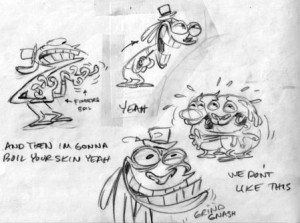 “Fil-Cartoons was a shithouse studio, and had no respect for the work we delivered,” as Bob Jaques stated. “I even witnessed a cameraman eating his lunch while shooting animation,” while Jaques worked there as a supervisor after animation for Stimpy’s Invention was being completed. By the second season, picked up in November 1991, Carbunkle’s episodes utilized a system at MetroCel in California, making Ren and Stimpy the first television cartoon to be digitally inked and painted, reducing the amount of technical errors. However, Jaques noted there are camera mistakes in Sven Hoek, despite the change in companies; in scene 99, when Stimpy opens and peers into a closet, searching for a board game, there is a hold in the middle of the action that was intended to be continuous, and a “fart” sound effect was used to cover up the mistake.
“Fil-Cartoons was a shithouse studio, and had no respect for the work we delivered,” as Bob Jaques stated. “I even witnessed a cameraman eating his lunch while shooting animation,” while Jaques worked there as a supervisor after animation for Stimpy’s Invention was being completed. By the second season, picked up in November 1991, Carbunkle’s episodes utilized a system at MetroCel in California, making Ren and Stimpy the first television cartoon to be digitally inked and painted, reducing the amount of technical errors. However, Jaques noted there are camera mistakes in Sven Hoek, despite the change in companies; in scene 99, when Stimpy opens and peers into a closet, searching for a board game, there is a hold in the middle of the action that was intended to be continuous, and a “fart” sound effect was used to cover up the mistake.
Nickelodeon ordered twenty episodes for the second season, though Kricfalusi was unable to deliver his six first season episodes on time as a director. By April, 1992, most of the twenty episodes were not fully written or boarded. As Spümcø’s costs increased excessively due to these delays, one of John’s solutions was to extend certain episodes to a half-hour—for instance, this episode.
 Bill Wray, one of the show’s principal background artists, spoke about Kricfalusi’s methods: “He had much higher aspirations, so he wanted to do every episode with a different feeling and a different level of style. It was like almost every cartoon is re-inventing the wheel, and that’s what made the show a challenge, made it fun, and also made it extremely difficult.” Nickelodeon offered an option to transfer most of the material to a different studio, while Spümcø worked on the better stories. Kricfalusi refused and was fired from the show, by the time Sven Hoek was finished.
Bill Wray, one of the show’s principal background artists, spoke about Kricfalusi’s methods: “He had much higher aspirations, so he wanted to do every episode with a different feeling and a different level of style. It was like almost every cartoon is re-inventing the wheel, and that’s what made the show a challenge, made it fun, and also made it extremely difficult.” Nickelodeon offered an option to transfer most of the material to a different studio, while Spümcø worked on the better stories. Kricfalusi refused and was fired from the show, by the time Sven Hoek was finished.
In-between the first and second season, Wray recalled John being pleased with his work. He encouraged Wray to draw storyboards on Sven Hoek, with Jim Smith. “Jim is kind of a quiet guy—self-effacing, and just likes to sit down and work, so I don’t think he was thrilled to be sharing his room with me,” Wray shared. “I was kind of hoping he would teach me stuff, but it kind of wasn’t his thing, so I just had to sort of wing it.”
 In drawing the boards together, Bill and Jim Smith drew different versions of Sven; Smith’s was considered “conservative” while Wray’s seemed more “goofy.” After John dissected their design, he drew his own interpretation of Sven using both Smith’s and Wray’s drawings. All three laughed as John created Sven, as seen in the final episode, as Wray described: “I don’t think I’ve had a day where just watching someone do an incredible drawing was such a funny experience, ever.” Wray pitched different jokes for the episode, including a sequence, cut during the storyboard stage, with Ren, Stimpy and Sven at the dinner table. Either John or Bill pitched the idea that Sven would be so brainless that he eats his own tongue, and politely offers sections to both Ren and Stimpy.
In drawing the boards together, Bill and Jim Smith drew different versions of Sven; Smith’s was considered “conservative” while Wray’s seemed more “goofy.” After John dissected their design, he drew his own interpretation of Sven using both Smith’s and Wray’s drawings. All three laughed as John created Sven, as seen in the final episode, as Wray described: “I don’t think I’ve had a day where just watching someone do an incredible drawing was such a funny experience, ever.” Wray pitched different jokes for the episode, including a sequence, cut during the storyboard stage, with Ren, Stimpy and Sven at the dinner table. Either John or Bill pitched the idea that Sven would be so brainless that he eats his own tongue, and politely offers sections to both Ren and Stimpy.
Sven Hoek was one of Stephen DeStefano’s first animated cartoon jobs, as layout assistant to Mike Fontanelli. He designed most of Fontanelli’s backgrounds, including Ren’s collection of rare, incurable diseases, the dinosaur droppings and the “Don’t Whiz on the Electric Fence” board game. DeStefano recalled: “There was a lot of pressure to get the layouts right; I don’t recall how long we had to do our work, but after a lot of struggle, we completed and submitted them for John’s approval. Some time after that, the entire layout staff was called into John’s office. We filed in, and all of our scene layout folders were on the floor. John told us the entirety of the work was completely sub par, and that we’d have to take it all back and simply do better. Everyone lifted their scenes off the floor, taking them back to be retooled.”
 “Route sheets” for second season episodes of Ren and Stimpy, animated at Carbunkle, have recently surfaced, offering insight to the animators’ work under Bob Jaques’ direction. However, there are discrepancies with the footage log; scenes 9 and 14 were animated by John K., but refined by Bob and Kelly. In scene 9, Bob animates Stimpy’s dialogue until he hops away for his appointment; he spent a week re-working the animation in-between directorial duties. Kelly reworked scene 14, of Stimpy flopping on the floor after being kicked in the head by a horse—Bob added the animation of Stimpy ticking after he lands.
“Route sheets” for second season episodes of Ren and Stimpy, animated at Carbunkle, have recently surfaced, offering insight to the animators’ work under Bob Jaques’ direction. However, there are discrepancies with the footage log; scenes 9 and 14 were animated by John K., but refined by Bob and Kelly. In scene 9, Bob animates Stimpy’s dialogue until he hops away for his appointment; he spent a week re-working the animation in-between directorial duties. Kelly reworked scene 14, of Stimpy flopping on the floor after being kicked in the head by a horse—Bob added the animation of Stimpy ticking after he lands.
Some of Carbunkle’s animators are credited on static background shots, given as free footage to the animators—for instance, Sven’s ball of used band-aids (scene 42) is credited to animator Ron Crown, and Chris Damboise (credited as “Dammer”) is listed for the close-up of the “Electric Fence” board game (scene 109). Bob animated the last two scenes in Sven Hoek, with Ren, Stimpy and Sven in Hell; he gave the money to effects animator Bob Bennett, hence his credit in the footage sheets. The close-up of Stimpy in scene 31 is credited to Bob Jaques, but it could be animated by Chris Ross, since it bears similarities to scene 22, in terms of the lip-sync—though Ross didn’t recall if he had worked on the later scene. Bob has no recollection animating the scene either, and attributed it to Chris, because there were problems attempting to get John K.’s mouth layouts to work in animation, which Jaques recalls discussing with Ross. About the earlier scene of Stimpy greeting Sven, Chris recalled: “Bob was very cool on that scene as the direction was basically ‘Make him look retarded’, so I did my best.”
 Despite the stressful nature of Ren and Stimpy’s production, the quality of the series stems from the artists’ love for traditional animation. Kricfalusi’s admiration for Bob Clampett’s cartoons is clearly evident in the series’ uninhibited nature—Stimpy is also modeled after a dopey cat from A Gruesome Twosome (1945). John also encouraged his artists to analyze Chuck Jones’ posing for staging and clarity in their work.
Despite the stressful nature of Ren and Stimpy’s production, the quality of the series stems from the artists’ love for traditional animation. Kricfalusi’s admiration for Bob Clampett’s cartoons is clearly evident in the series’ uninhibited nature—Stimpy is also modeled after a dopey cat from A Gruesome Twosome (1945). John also encouraged his artists to analyze Chuck Jones’ posing for staging and clarity in their work.
Different animators and series of the Golden Age, including Rod Scribner, Jim Tyer, the Fleischer Popeye cartoons and Hanna-Barbera, both for their work on Tom and Jerry and their television programs, were important influences. Bob Jaques was inspired by Bobe Cannon’s animation in Tex Avery’s Wags to Riches (1949), with Sven whipping into scene in front of Stimpy’s closet (scene 91). “I felt at the time, and still do now, that we were doing a unique style of animation that married both “real” acting and expression with a cartoony style that pushed boundaries,” said Chris Sauve. “There was an energy to the studio born from the combination of working hard, then goofing off, watching old cartoons and learning from them, then turning around and putting what you were learning directly into your work.”
 Sven Hoek is an exception to the rule that dumb characters in cartoondom deserve their mistreatment—stupidity in this episode is celebrated. Stimpy worsens his idiocy during his daily “appointments” to have his head kicked by a horse, which results in a spastic attack, as he sits on the floor, babbling into an imbecilic bliss before Ren nearly strikes him with a baseball bat. Evidently, these scenes of Stimpy’s possible skull damage were based on a real incident where Jim Smith’s brother Doyle was kicked in the head by a mule.
Sven Hoek is an exception to the rule that dumb characters in cartoondom deserve their mistreatment—stupidity in this episode is celebrated. Stimpy worsens his idiocy during his daily “appointments” to have his head kicked by a horse, which results in a spastic attack, as he sits on the floor, babbling into an imbecilic bliss before Ren nearly strikes him with a baseball bat. Evidently, these scenes of Stimpy’s possible skull damage were based on a real incident where Jim Smith’s brother Doyle was kicked in the head by a mule.
As animated by Chris Sauve, he claims to have received the most feedback on his animation of Stimpy’s reaction to the kick (scene 15). Sauve made a clear point about the scene, in a way that could be said about most of the Golden Age animators profiled on this particular column, if one were to laud certain points of their work: “It was one of those shots that you don’t think is that important at the time you’re animating it. You’re just trying to get the thing done and approved by week’s end because you have another bunch of shots to get to. I think this is a common occurrence with animators, that sometimes that shot you don’t think about too much while doing it becomes something you’re known for doing.”
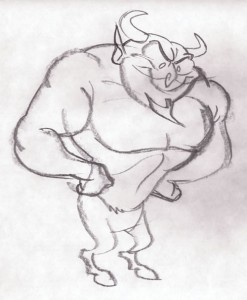 Like children forming a new friendship at a playdate, Stimpy and Sven share their repulsive habits, display each other’s pea-sized brains. Much to Ren’s chagrin, they place rubber gloves on their heads and form their own lodge, “The Loyal Order of Stupids.” Later in the episode, their stupidity is on the verge of annihilation, as an infuriated Ren looks upon the destruction of his home and prized possessions by Stimpy and Sven. Bob Jaques and Kelly Armstrong animate on a few portions of this sequence, as Ren menacingly threatens the two frightened children, turning their home into an eerie nightmare. His performance is reminiscent of Robert Mitchum’s in Night of the Hunter (1955). “I would listen to the tracks over and over and act with them, flipping the layouts and eventually starting to draw. I’m not too much into subtlety, so I always preferred scenes where there was some meaty action or high drama,” Armstrong said of her work on the show.
Like children forming a new friendship at a playdate, Stimpy and Sven share their repulsive habits, display each other’s pea-sized brains. Much to Ren’s chagrin, they place rubber gloves on their heads and form their own lodge, “The Loyal Order of Stupids.” Later in the episode, their stupidity is on the verge of annihilation, as an infuriated Ren looks upon the destruction of his home and prized possessions by Stimpy and Sven. Bob Jaques and Kelly Armstrong animate on a few portions of this sequence, as Ren menacingly threatens the two frightened children, turning their home into an eerie nightmare. His performance is reminiscent of Robert Mitchum’s in Night of the Hunter (1955). “I would listen to the tracks over and over and act with them, flipping the layouts and eventually starting to draw. I’m not too much into subtlety, so I always preferred scenes where there was some meaty action or high drama,” Armstrong said of her work on the show.
For others, it was tricky. Jamie Sutton (his last name was Mason at the time of Sven Hoek) animated a four-foot scene of Stimpy and Sven’s terrified reactions, holding their arms, in scene 137. “It was more work than it was worth, because of the stagger, and then the lip sync had to register to the head correctly, and then the sweat had to flow down in such a way that it didn’t hit everything. Also, doping it was a bit of a pain because of all the levels and it being on ones.” By the end of the episode, Ren’s retribution, by urinating on their favorite board game, sends them into the depths of Hell.

This copy of Sven Hoek re-instates a few cut sequences, including an extended scene which Sven and Stimpy play “circus” in the litter box behind closed doors. Another cut scene shows Ren threatening to gouge Stimpy and Sven’s eyes out is shown here as well (hence, the time code). However, Ren unzipping to urinate on their board game cuts to a disarranged freeze-frame of Stimpy and Sven in the middle of his dialogue—this was an error from the edit for the DVD.
For more information about The Ren and Stimpy Show and the artists involved, I’d like to recommend Thad Komorowski’s extensive book Sick Little Monkeys, currently being updated for a revised edition.
Now sit down and watch, you mindless buffoons!
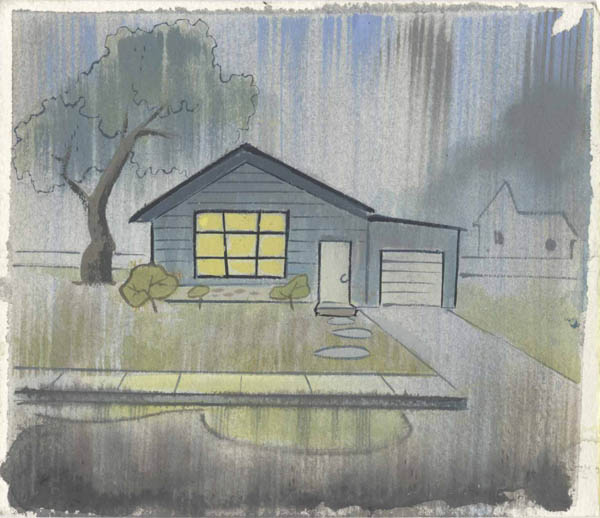
Color Key
(Thanks to Jerry Beck, Thad Komorowski, Frank Young, Bob Jaques, Kelly Armstrong, Bill Wray, Stephen DeStefano, Jamie Sutton, Chris Ross and Chris Sauve for their help.)


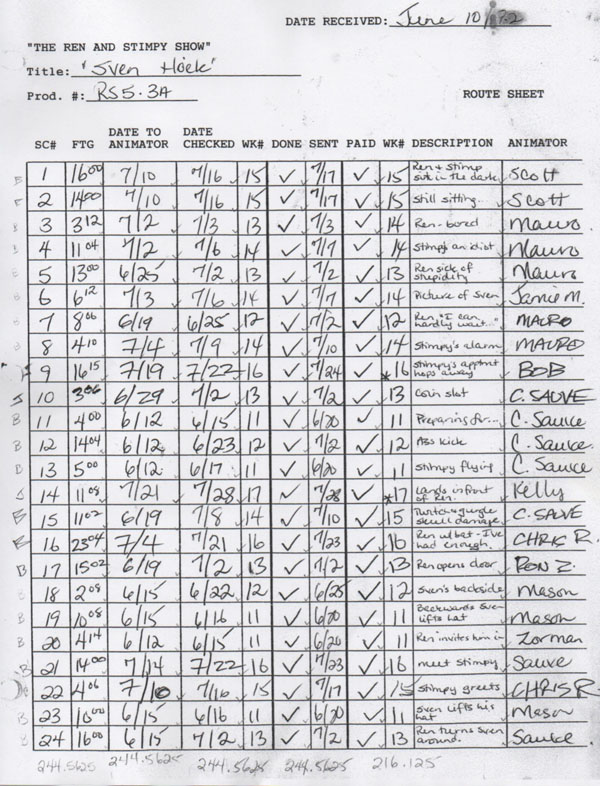



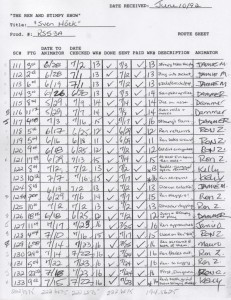

 DEVON BAXTER is a film restoration artist, video editor, and animation researcher/writer currently residing in Pennsylvania. He also hosts a
DEVON BAXTER is a film restoration artist, video editor, and animation researcher/writer currently residing in Pennsylvania. He also hosts a 





















































































“Fil-Cartoons is a $#|+house studio”
Boy did Bob Jaques got that right! As I remember Tiny Toon Adventures here’s the list of the animation studios who animated Tiny Toon Adventures from best to worst…
Tokyo Movie Shinsa (TMS) Japan
Startoons Chicago Ill USA
Akom (South Korea)
Wang Cuckoo Nest (Taiwan R.O.C.)
Freelancers (New Zealand)
Kennedy Cartoons (Toronto Ontario Canada/Manila Philippines)
&
Fil-Cartoons (Philippines) [which was owned by Hanna Barbera]
In fact Fil-Cartoons was so bad on how they animated Tiny Toon Adventures that Warner Brothers fired them after season one.
You forgot Encore Cartoons, though maybe that was intentional. And are we sure it was WB who fired Fil-Cartoons? Only halfway during the first season, Kennedy was having its ink and paint done by Wang.
Anyway, back to “Sven Hoek”. It’s hard to pick a favorite animator in the cartoon- they all do a good job, but Ron Zorman, Bob Jaques, and Kelly Armstrong animated the bulk of Ren snapping at Stimpy and Sven, which is my favorite scene in the cartoon (and my top five of the series in general).
This is damn well one of my favorite R&S episodes and I’m glad it’s one of the ones Carbunkle got to animate. So delightfully STOO-pid and funny. The scenes of Ren reacting to psychotic horror to both Stimpy and Sven’s unfathomable stupidity is one of the things that sets Ren apart from any other animated character in the medium; nobody “acts” in animation (especially as a deranged psychopath) quite like he does.
The way Ren says, “I’m gonna HIT ‘cha” absolutely KILLS ME every time. Funniest freaking thing ever.
My favorite bit is: “Good. You’re scared, huh?”
All I can say is that I sure wish a revised edition of the original REN & STIMPY series would be issued on DVD so that we can see the uncensored episodes. Thanks for sharing this.
One thing is for sure – it won’t be Shout! Factory because they claim not to have the DVD rights for R&S.
This and Stimpy’s Invention were always my favorite episodes because of the wonderfully deranged animation. stop-framing on the more inventive bits was a real treat. By the way, anyone know who played the guy in the opening titles?
That was Bob Camp.
I had seen comments and old badly written essays about animation and interviews that also said Camp was the guy in the intro – I sent messages to him and he replied — it wasn’t Bob Camp.
Camp in his reply talked with me about old movies (a favorite – SEVEN SAMURAI and one that he really liked was called THE LOVED ONE – movie with R. Morse) and in his typed message to me said something to the effect of the guy ‘was not me’ and the guy “…they hired came in, and he also had his own squeeze box”.
SB
–
AjenoDel
FWIW, John K. said it wasn’t, and Cinefantastique didn’t say it was Bob either.
It’s one of those things that’s probably lost to the ages.
I’m sure Kevin. That title sequence was pretty unconvential and unexpected for its time, too. I just like to think they asked someone, “Hey could just step into the studio wearing this get-up and move the according back and forth for us?” That’s pretty much how it comes off to me. They just needed something to go with the obvious foreign character we’re going to meet here.
I noted that some of Bob jaques’ poses during Ren’s creepy rant are a little angular. I also have a soft spot for the expressions on Jamie Oliff’s scenes.
I believe that Fil-Cartoons was only good at animating H-B’s product; some of their Flintstones specials and World Premiere Toons look nice.
We were required to use the layout drawings so if they had angles in them, it was carried over to the animation.
The article states that Fil-Cartoons did ink and paint only, not animation.
(For R&S…I don’t know about other shows.)
Fil-Cartoon only did Ink & Paint on R&S’s first season of course, for other productions, they were either the ink & paint go-to’s or they had them animating too, though mostly on H-B’s work since they owned the studio, much in the way they co-owned the one down in Australia before that brached off into its own thing.
Reminded, though I’m sure Ishared this before, but I did spot this one video on YouTube made by the Fil-Cartoons staff as a thank-you to a former head of the studio, Jerry Smith.
https://www.youtube.com/watch?v=EvOklYNUIQk
http://www.awn.com/mag/issue2.4/awm2.4pages/2.4tributesmith.html
Here’s a promo vid featuring some of FIl-Cartoon’s staff and productions, including the World Premiere Toons…
https://www.youtube.com/watch?v=robniriOYS0
The saga of this episode is one of the most interesting of the original one. On top of everything you said, it was the first episode to air after the firing, and thus the first with any Games input. There’s a myriad of different versions of this one episode floating around between workprints, different levels of censorship, an alternate soundtrack, and the haphazard “Uncut” version on the DVD.
I would love to see an truly Uncut version, with everything put back in. As unlikely as that is now.
We can still dream. It is interesting thinking how many versions they’re are. I recall the first airing with the music different from the way it appeared later on.
His titles for the Shelly Long feature film Troop Beverly Hills (1989) went unnoticed.
It was quite a short notice there, from an era when movies still had opening titles and animating those was something you saw a lot. I do recall Troop Beverly Hills titles personally, but at the time I probably didn’t add it up in my mind that they were John’s despite the look. It’s true though his approach and style was coming to a head by the time Ren & Stimpy finally got on the air, all those earlier efforts were simply build-ups to the big time.
By the second season, picked up in November 1991, Carbunkle’s episodes utilized a system at MetroCel in California, making Ren and Stimpy the first television cartoon to be digitally inked and painted, reducing the amount of technical errors.
Not exactly correct if you count the earlier Hanna-Barbera efforst on their computer system they’ve used since the mid 80’s on shows like The Jetsons, A Pup Named Scooby-Doo and a few others. Ren & Stimpy’s second season with episodes done at MetroCel may otherwise ignite that trend we saw in the 90’s of certain shows either being produced on film or digitally, depending on costs and availabilty. It was a rather rocky transition and it certainly noticable when a show may have a first season or even a pilot done in the older method, only to go digitally soon after (South Park’s pilot comes to mind).
Some of Kricfalusi’s other pitch ideas include (from Vanessa Coffey herself) He Hog, The Atomic Pig and Jimmy the Hapless Idiot Boy, according to a recent article in Entertainment Weekly: http://jawilson19k.tumblr.com/post/150455296860/oral-anecdotes-on-nicktoons-25th-anniversary-from
Re: Bill Wray. I love his work. I bought Mad magazine for years longer than I otherwise would have because of Wray’s “Monroe” comic.
Bill Wray also wrote a episode for Dexter’s Labratory entitled “Sore Eyes”.
Was the “He is Ollie, you are Sven” business derived from the Flintstones’ episode “Swedish Visitors”?
Yes.
How come this episode has two versions with two soundtracks?
I think there were some music rights issues, because one of the tunes deleted from the ultimate soundtrack is Raymond Scott’s Huckleberry Duck.
It wasn’t because of rights issues. Huckleberry Duck is in both soundtracks (and on the VHS/laserdisc/DVD).
I believe the soundtrack was done to make the dialogue easier to understand. John K complained about the music and SFX of the original soundtrack when the episode first aired because they were intrusive and distracting.
For posterity, the revised soundtrack first aired on MTV in January 1993, as part of a marathon. It became the default soundtrack for Sven Hoek by May 1993 and was the one used when it was released on VHS in 1994. The “Uncut” DVD is the only home release with the original 1992 soundtrack.